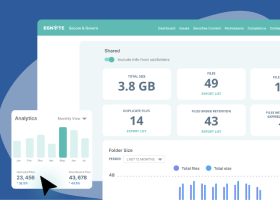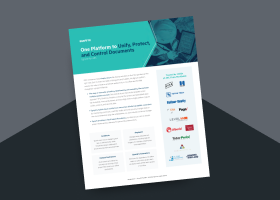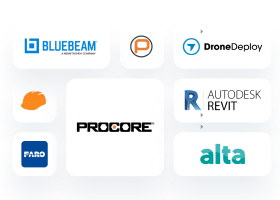Exploring Construction Management Software
Let’s jump in and learn:
- What Is Construction File Management?
- Construction Management Software: How It Works
- Construction Management Software for Small Businesses
- Construction Management Software for Subcontractors
- Construction Management Software for Owners
- Why Organizations Need Construction File Management
- Increase Project ROI with a Construction File Management System

What Is Construction File Management?
Construction management software is a platform designed to meet the needs of a construction company by automating and digitizing processes.
Construction management software is used by companies of all sizes, from small businesses to multi-national builders with commercial and residential operations. It helps in several ways, including bidding, budget management, communication, quality and safety, scheduling, decision-making, vendor management, materials tracking, and job scheduling, by driving efficiency with automation and digital processes.
Builders realize many benefits with construction management software, including in the following areas.
- Budget management
With construction management software, managers can more easily manage costs. Among the construction management accounting capabilities, construction management software includes tools that help teams quickly locate documents (e.g., contracts, change orders, budget status).
This helps reduce project costs and prevent issues that can increase costs or misuse the allocated budget. Construction management software also reduces operational costs and provides ready access to project-related financial data, which can make the project more profitable.
- Construction document control
Access and sharing are important features of construction file management as they are essential to every project. With construction file management, all project-related document storage is in the system allowing users to access information and share it with other team members from a single place.
Construction file management also captures data for audit log records. These records include the date and time of document creation and modifications. It also provides security systems to control access to files and support the principle of least privilege.
- Construction file management
Document management and construction file management are critical components of the success of a project because of the volume of documents and files generated—from permits to safety reports. Most construction management software supports construction document control and file management.
Construction management software helps teams digitize documents and workflows and automates several processes, eliminating error-prone manual processing. The construction file management and document control with construction management software make sure documents are safe, accessible, and audit-ready.
- Construction risk management
Construction management software keeps project documents organized, which helps management teams identify and resolve potential issues that could jeopardize project success. - Client service enhancement
Construction management software facilitates efficient project delivery to enhance client service and satisfaction.
By bringing all aspects of a construction project into a centralized system with a unified view of all aspects of a project, construction management software helps teams work together, increases efficiency, streamlines operations, and improves profitability.
With this comes on-time, within-budget projects that lead to enhanced reputation, referrals, and, ultimately, increased revenue. - Facilitates construction management
Using a construction management software solution helps make it easier for everyone on the team to stay organized, resulting in numerous benefits to the organization. Construction management software allows staff to ensure that projects go smoothly, according to project plans.
It enables management to set objectives and track progress from a central location. With construction management software, management can also communicate with individuals or teams and maintain a log of the messages, which helps with audits.
Construction Management Software: How It Works
For the most part, construction management software is cloud-based and available from any connected device via desktop or mobile application. Contractors, subcontractors, and business owners can log in to check various job sites without requiring on-site or office visits.
Since all information related to a construction project is centrally located, everyone involved can access the information they need according to their authorization levels. In addition, construction management software enables collaboration between everyone involved in a project.
Construction management software is purpose-built to support these task-driven milestones. With construction management software, tasks in a project are organized around plans and trades. This, and the supporting documents behind each task, keep teams in the field and the office abreast of all milestones, from pre construction through closeout.
Construction Management Software for Small Businesses
Small construction companies benefit from construction management software in several ways. Overall, the automation and operations optimization provided with construction management software make it a must-have for small businesses. Following are several reasons small businesses rely on construction management software.
Automation of construction processes
Enabled construction management software streamlines activities, eliminates manual errors, and creates accountability, keeping small businesses’ projects on time and within budget.
Bid management functionality
Construction management software saves time and streamlines bidding with a single platform to keep all parts of the bidding process in one place and easily accessible for a current project or reuse for subsequent projects.
Field productivity tools
Construction management software allows project managers to track productivity without administrative tedium, double-entry, or complex and siloed spreadsheets.
Project management
Is facilitated with construction management software because it provides a platform to support real-time communications and easy access to information.
Quality and safety control
Is simplified and made more effective with construction management software because it helps teams identify, understand, and connect any jobsite issues and helps assess potential risks.
Single source of truth
A key function of construction management software as it provides a central location for all construction-related information.
This streamlines operations in several ways, allowing team members to improve bid accuracy, view the daily log calendar, search across all drawings or photos, access change management from the field, and track invoices.
Support for operational process standardization
Deployment of construction management software creates a platform for optimal construction project efficiency by bringing workflows into systems that keep teams focused and accountable. This also mitigates risk by eliminating the potential for human errors.
Visibility into construction projects
Made possible with construction management software, the platform connects people, systems, and data giving team members access to the most up-to-date information (e.g., documents, approvals, communications, drawings, photos) when and where they need it.
This supports informed decision-making, which keeps projects on track. It also allows managers to keep track of who is doing what, which helps them to better establish and enforce accountability across all projects and team members.
Construction Management Software for Subcontractors
Subcontractors use construction management software to support both field and office workers. Construction management software helps subcontractors get paid for their work (i.e., eliminate “free” work) with a platform that can be used to gather, share, and analyze all vital project documents and data.
With construction management software, subcontractors can track and manage all costs, deadlines, deliverables, and correspondence to ensure that subcontractors never miss getting paid or lose money on a job. The following are additional reasons why subcontractors should use construction management software.
- Allows for instant notification, via text or email, about a job, such as when a task is assigned, what work has yet to be completed, punch list status, or inspection scheduling and preparation
- Automatically communicate work completed
- Capture and collect as-built project information throughout all phases, including status updates, photos, 360° photos, and video to create an indisputable record of work performed on the jobsite
- Coordinate tasks with different trades
- Enables real-time communication to address issues, whether in the office or on a jobsite—between anyone on the team
- Handle schedule mitigation as soon as a change requires it
- Increase jobsite productivity by enabling teams to access documents and collaborate when out of the office
- Keep the entire team working from the most up-to-date versions of the project drawings
- Know exactly who did what work, when, where, and why
- Optimize labor usage across projects
- Organize and record messages related to all aspects of a project
- Provide access to everything from submittals to inspections to plans to RFIs from any mobile device
- Record and prioritize tasks
- Use the same workflow across different job sites
Construction Management Software for Owners
Owners also benefit from using construction management software. The following are three reasons why owners choose to use construction management software.
1. Collaboration—Construction management software facilitates communications and collaboration amongst and between teams and other stakeholders, including project managers, subcontractors, and suppliers.
2. On-site accessibility—Cloud-based construction management software can be accessed from most jobsites with connectivity, allowing teams to access any project-related information when needed. Construction management software eliminates rushed trips to offices to pick up papers and ensures that teams work with the latest document version.
3. Project oversight—Project managers can more effectively oversee all details to ensure that everything from supplies to subcontractors is accurately accounted for—start to finish.
Why Organizations Need Construction File Management
1. Adds mobility to project managers’ toolkit allowing everyone on the team to communicate, save, access, and share information from a common application accessible from anywhere on mobile devices—from uploading photos and documenting change orders to signing contracts and pulling up permit information.
2. Allows team members to edit and markup documents in real-time, ensuring that everyone is working on the most current file and eliminating rework and related costs.
3. Capturing and saving digital signatures is much more efficient and manageable than tracking down and storing signatures on paper.
4. Consolidates and centralizes all the construction document sources and makes them easily accessible.
5. Controls and reduces paper-based expenses in several ways, including dispensing with budget items for copies, paper, and couriers.
6. Delivers the highest levels of security from information storage protections to access controls to ensure that information cannot be tampered with, accidentally changed, stolen, lost, or accessed by unauthorized users.
7. Dispenses with cumbersome paper documents that get misplaced or destroyed. This causes project delays and creates confusion, resulting in costs to the project owners by capturing and organizing all information digitally and storing it in a central location.
8. Eliminates the need to upload and download information into different applications with the aggravation of locating files or file format compatibility.
9. Enhances communication across all stakeholders on a construction job to avoid project delays, including:
- Contractors who may not present during staff meetings but benefit from reliable access to information discussed in these meetings
- Project managers can use the construction file management system to keep all project members up to date with the latest information
- On-site teams who are often sidelined in communication can have access to the critical information that affects them
- Finance teams benefit from construction file management with an improved organization that reduces the average time spent on procurement
10. Gives teams instant access to the information they need quickly without having to rifle through paper files that could be in different locations.
11. Helps with evaluations as to whether a project is on track (i.e., schedule and cost) and provides early warning if adjustments need to be made to address issues that could push the project out of scope and over budget.
12. Improves quality management with the ability to generate reports on any quality relationship, such as with the source, electrical installations, material suppliers, prevention of occupational hazards, absenteeism, and risks due to accidents on the job.
13. Keeps everyone working on a project accountable by capturing all data throughout a project and properly organized within categories to make it easy to track down the source of an issue and assign accountability.
14. Minimizes risks associated with multiple copies of documents causing version control issues with software that tracks changes, maintains copies of previous versions, and sends notifications when someone is working on a document.
15. Prevents the recurrent issue of cost overruns by streamlining the document management process, which keeps everyone aware of a project’s progress and changes, as well as which tasks to execute on time and which ones to overlook to reduce costs and save time.
16. Protects the company if clients or third parties ask questions about the team’s performance on a specific building aspect.
17. Provides ready access to every document type in a central, secure location, from bidding and contract documents to change orders and payment requests.
18. Reduces the chance of mistakes that could lead to costly conflicts, claims, or lawsuits, which not only cause financial loss but also result in significant project delays.
19. Simplifies responses in the event of an audit with detailed records that cover finances, inspections, contracts, safety, labor, and transactions, which saves time and money.
20. Streamlines file management with automation, which helps to enforce file naming and storing protocols and saves time on doing it manually.
21. Supports implementing and applying policies and procedures that management put in place to ensure a smooth project that stays within budget.
Increase Project ROI with a Construction File Management System
Take advantage of cloud-based construction file management systems for added convenience and effective communication, streamlining operations, and saving time, resulting in increased project profitability.
Remember, it is essential to regularly evaluate the performance of a construction document management system to ensure that it is performing optimally and team members are using it correctly.
Egnyte has experts ready to answer your questions. For more than a decade, Egnyte has helped more than 16,000 customers with millions of customers worldwide.
Last Updated: 22nd February, 2023



